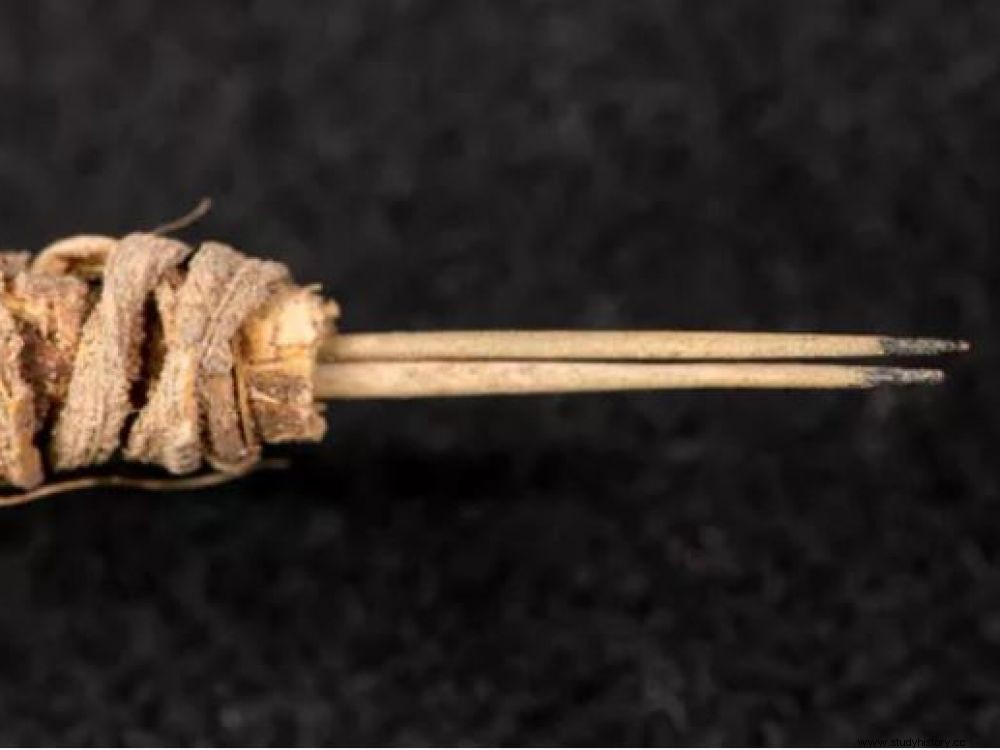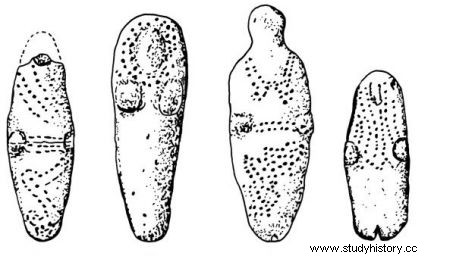The discovery of a tattoo needle sets back the knowledge of this practice on the North American continent by 1000 years.

Close up of a 2000 year old tattoo tool.
Almost a needle in a haystack, so exceptional is the discovery of such an accessory! It was while carrying out an inventory of archaeological objects preserved for forty years in the dusty reserves of the museum of Washington State University (WSU), in the United States, that the attention of a young anthropologist was drawn to a utensil he had never seen… Two prickly pear cactus thorns, attached to a sumac handle (Rhus trilobata ), wrapped in yuca leaves (Yucca spp.). The researcher's curiosity was especially piqued when he noticed that the ends of cactus spines, dyed black, made them look like tattoo needles.

The complete tattoo instrument as discovered at the site of Turkey Pen, Utah. ©Washington State University / WSU
In an article published in the Journal of Archaeological Science dated February 28, 2019, Andrew Gillreath-Brown and his colleagues at Washington State University thus demonstrated that they had undoubtedly unearthed a precious tattooing instrument, in boxes gathering the archaeological remains of Turkey Pen. A site unearthed in 1972 in the cliffs of the Greater Bears Ears region, and its spectacular landscapes in southeastern Utah (United States). The tattoo is an artistic expression common to many cultures in the world. 5,300 years ago, the body of Otzi, the "ice man" found in the Dolomites (Italy) was adorned with it, as were 2,300-year-old Egyptian mummies. But getting your hands on the tools that enabled these accomplishments is not common. In this case, in the American case, this find provides evidence of tattooing practices hitherto unknown, by indigenous cultures ancestors of the Pueblo, famous later for their prestigious adobe architectures of Chaco Canyon or Pueblo Bonito, in the north of New Mexico.
Almost a needle in a haystack, so exceptional is the discovery of such an accessory! It was while carrying out an inventory of archaeological objects preserved for forty years in the dusty reserves of the museum of Washington State University (WSU), in the United States, that the attention of a young anthropologist was drawn to a utensil he had never seen… Two prickly pear cactus thorns, attached to a sumac handle (Rhus trilobata ), wrapped in yuca leaves (Yucca spp.). The researcher's curiosity was especially piqued when he noticed that the ends of cactus spines, dyed black, made them look like tattoo needles.

The complete tattoo instrument as discovered at the site of Turkey Pen, Utah. ©Washington State University / WSU
In an article published in the Journal of Archaeological Science dated February 28, 2019, Andrew Gillreath-Brown and his colleagues at Washington State University thus demonstrated that they had undoubtedly unearthed a precious tattooing instrument, in boxes gathering the archaeological remains of Turkey Pen. A site unearthed in 1972 in the cliffs of the Greater Bears Ears region, and its spectacular landscapes in southeastern Utah (United States). The tattoo is an artistic expression common to many cultures in the world. 5,300 years ago, the body of Otzi, the "ice man" found in the Dolomites (Italy) was adorned with it, as were 2,300-year-old Egyptian mummies. But getting your hands on the tools that enabled these accomplishments is not common. In this case, in the American case, this find provides evidence of tattooing practices hitherto unknown, by indigenous cultures ancestors of the Pueblo, famous later for their prestigious adobe architectures of Chaco Canyon or Pueblo Bonito, in the north of New Mexico.

Former Utah cliff pueblo habitat, similar to Turkey Pen site. ©George Frey / Getty Images North America / AFP
Collected in a naturally protected cave, in the middle of organic remains of hair, charcoal, corn cobs or… even coprolites (fossilized stools), the object could be dated. Radiocarbon analyzes have been able to link the occupation of Greater Bears Ears to the so-called Basketmaker populations, a prehistoric Native American culture of sedentary basket weavers who lived between 50 BC and 200 AD. JC. This dates back at least 2000 years the use of these tattoo needles by the ancient inhabitants of the southwestern United States.

Clay figurines of basket weaver farmers from Canyon de Chelly (Arizona), wearing tattoos and body decorations. ©Washington State University / WSU
Or a practice 1000 years earlier than we imagined. To examine the chemical composition of the cactus tips, and the black hue that still impregnated them, the experts carried out analyzes by X-ray fluorescence spectrometry, revealing carbon-based pigments. The publication of the Journal of Archaeological Science recalls that many ceramics and decorated vases encountered in the regions of the American Southwest, included characters with painted and tattooed bodies and faces. Creations described within the ancestral traditions Pueblo, Mimbres, Hohokam, or those of the Hopi and Mojave Indians.
